
Because it differs in chemical makeup than other hair colors, red hair does not respond well to the same bleaching processes. All hair contains two types of pigments: phaeomelanin and eumelanin. Where dark hair contains more eumelanin, red hair contains more phaeomelanin. Because eumelanin responds more easily to bleaching action than phaeomelanin, red hair requires a stronger bleaching process than dark black hair. But even though red hair may give you some trouble, a little tenacity will get it to the color you want.
Apply 20-volume peroxide to the back of the hair near the nape of your neck. Do not rub into the scalp or you might suffer discomfort or even burns from the bleach.
You may use 30-volume for naturally dark red hair, but pay close attention to your scalp. The second you feel pain, rinse out the peroxide.
Quickly continue to apply bleach toward the front of your head.
Wipe any bleach off of your forehead, ears and the back of your neck.
Cover your hair with a shower cap.
Bleach loses its effectiveness when it dries, so covering the hair allows the bleach to stay moist.
Attach your diffuser to your blow dryer’s nozzle. Blow dry the hair, through the cap.
To avoid patchy hair color, keep the heat even.
Watch your hair color closely. Stop when you reach the desired result or after 30 minutes, whichever comes first.
Repeat the bleaching process, if you did not reach the desired color. Always wait a few days to let the skin on your scalp repair itself.
Tone your hair, using semi-permanent ash or neutral blonde in the color you want your hair. Semi-permanent hair color does not “lift” (lighten your hair), but instead deposits color on your pre-lightened hair. Because red hair shows more difficulty in lightening, it can turn orange or brassy. Toner cuts this brassiness.
Condition your hair using a protein-based conditioning treatment.
Related Articles

How to Make Hair Stripper

How to Get Brown Hair Back to Gray

How to Use a Toner When Coloring Hair

How to Bleach & Tone Hair
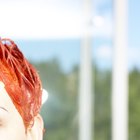
How to Remove Red Hair Color With ...

How to Stop White Hair From Turning ...

How to Keep Burgundy Hair Vibrant

Hair Color Rinse Vs. Hair Color Dying

How to Change Colored Hair From Red to ...
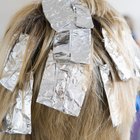
How to Turn Orange Highlights to Dark ...

How to Cover White Hair with Light ...
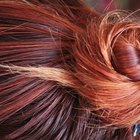
How to Mix & Apply Toner to Brassy Hair
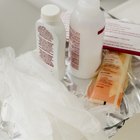
How to Get the Brass Out of Your Hair ...

How to Darken Bright Red Hair

How to Cover Gray at the Temples

How to Protect Hair from Swimming Pool ...

How to Remove Henna From Hair

Can I Dye My Hair After Bleaching It?
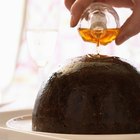
How to Color Hair With Molasses

How to Bleach Dyed Brown Hair
References
Writer Bio
Donny Quinn has been writing professionally since 2002 and has been published on various websites. He writes technical manuals for a variety of companies, including restaurants, hotels and salons. Quinn is pursuing a Bachelor of Arts in English at Georgia State University.
Photo Credits
face of blonde image by jimcox40 from Fotolia.com